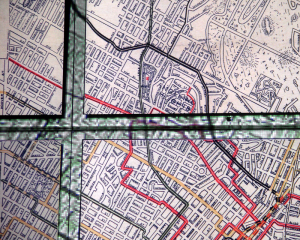Home » Featured Articles » Improving the Usage of Large Display Environments
Improving the Usage of Large Display Environments
Of the machine components that are part of visual analytics, human-computer interaction, and visualization, the display has one of the largest effects. The display determines the physical size of the viewport, the range of effective field-of-view and resolution that is possible, and the types of feasible interaction modalities.
All other interactions must be placed in the context of the display. If you have ever seen a movie on a large screen TV, then you have been surely impressed with the captivating display that makes the viewing innately attractive. This is not limited to entertainment alone. People get the same sensations, impressions, and further their understanding of displayed information in more serious applications. So we need to understand how we can use them most effectively and where the advantages and disadvantages of this medium are.
As large screens have become cheaper and more commonplace in our environments, the research need has become more urgent. Large displays are either a single display device or an assembly of display devices. In their survey, Ni et al. [IEEE VR 2006] distinguish six display hardware configurations. In our research, we focused on the following two setups:
- Tiled LCD panels, projector arrays: Tiled displays are 2D arrays build of common LCD displays or projectors. Compared to projectors, LCDs usually are less expensive, easier to align, and take less space. On the other hand, projector arrays do not have bezels between each tile.
- Stereoscopic displays: By computing an image for each eye, these displays provide three-dimensional visualizations to the viewer. In order to see the 3D effect, the user typically has to wear special glasses. Compared to 2D high-resolution displays, they usually have a much lower resolution.
In addition, Ni et al. present their top ten research challenges in the area of large high-resolution displays. The first two topics on their list are truly seamless tiled displays and stereoscopic large high-resolution displays. We have developed two new focus+context screen metaphors to address both problems.
Our first metaphor focuses on LCD-based multi-monitor systems and makes a contribution to address the bezel problem, i.e., to cover the missing bezel information. For many applications, data is continuous and correct spatial relationships are needed to interpret information in the right way. Here, monitor bezels can be very distracting and interfere with the objective of providing precise visualizations of the data.
Our approach is to enhance the bezel area by projecting the missing image information directly onto the bezels. Thereby we create a nearly seamless image, which is composed of the high-resolution information displayed on the monitors and somewhat lower resolution information projected onto the bezels to fill the gaps. We were able to show that it is possible to bypass the drawbacks of conventional tiled display techniques with minimal effort. Our hybrid approach combining different display technologies is able to produce an almost seamless tiled display avoiding discontinuities while at the same time maintaining a majority of pixel information.
The second metaphor addresses large stereoscopic displays. The technical limitations of such projective systems usually result in a loss of detail and sharpness of the visualized information. These limitations especially disadvantageous, in cases where two-dimensional context information (like user manuals, measurements, menus, etc.), need to be displayed.
To accommodate these problems, we present a novel approach called 5DF+C, which introduces a focus+context screen for large virtual environments. The concept is implemented by enhancing a common 3D projective system with a third (high resolution) projector. Here, the additional projector is used for displaying an additional high resolution 2D focus area. We were able to show that our 2D+3D focus+context screen improves the users’ performance with respect to both reading time and error rate significantly.
In summary, both metaphors make use of an additional projector and result in two new focus+context screen approaches. In the future, we are planning to investigate how new interaction techniques specifically tailored to both setups can further improve the users’ cognitive performance in complex scenarios.
This aims at developing interaction metaphors that seamlessly support the user both in a 3D and in a 2D environment. We expect such new integrated interaction techniques to augment additionally the gain in performance and efficiency that we have already achieved with our presented approaches.



0 Comments
You can be the first one to leave a comment.